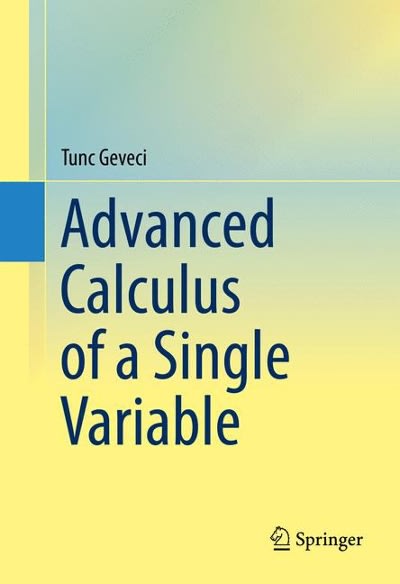Question
Instructions: Answer every part of each question. Make sure to read each problem carefully and show all of your work (any calculations/numbers you used to
Instructions: Answer every part of each question. Make sure to read each problem carefully and show all of your work (any calculations/numbers you used to arrive at your answers). Problem 1: The average salary for California public school teachers in 2019-2020 was $84,531. Suppose it is known that the true standard deviation for California teacher salaries during that time was $19,200. Use this information to answer the following questions. Question 1a (1 point): Suppose you knew that the distribution of California teacher salaries was skewed right. If you took a random sample of 40 California public school teachers, would you be able to utilize the Central Limit Theorem for this scenario? Justify your answer. Question 1b (1 point): Suppose you took a random sample of 50 California public school teachers and recorded their average salary. What is the probability that their average salary is greater than $77,000? Round your answer to 3 decimal places (i.e. if your answer was 0.54321 then you would write 0.543) Question 1c (1 point): Suppose you took a random sample of 50 California public school teachers and recorded their average salary. What is the probability that their average salary falls between $60,000 and $80,000? Round your answer to 3 decimal places (i.e. if your answer was 0.54321 then you would write 0.543) Question 1d (1 point): Suppose you took a random sample of 50 California public school teachers and recorded their average salary. What is the probability that their average salary is no more than $85,000? Round your answer to 3 decimal places (i.e. if your answer was 0.54321 then you would write 0.543) Question 1e (1 point): Suppose you took a random sample of 50 California public school teachers and recorded their average salary. What is the probability that their average salary is either less than $82,000 or greater than $85,000? Round your answer to 3 decimal places (i.e. if your answer was 0.54321 then you would write 0.543)
Problem 2: In 2018, the FIFA World Cup was hosted by Russia. A sports analyst was interested in determining the true average attendance at each of the matches. However, they were unable to attend every match, so they randomly selected 32 matches to attend and recorded the attendance at each one. They found that the average attendance at those 32 matches was 46,875 with a standard deviation of 4,172. Question 2a (4 points): Use this information to construct and interpret a 93% confidence interval for the true average attendance at 2018 FIFA World Cup matches. Make sure to check all assumptions and state how they were satisfied. Round each value in your interval to 2 decimal places (i.e. if your answer was 0.54321 then you would write 0.54) Question 2b (1 point): How would a 99% confidence interval for the true average attendance compare to the 95% confidence interval you constructed in part (a) if all other values were held constant?
Problem 3 (5 points): Kristen Gilbert was a nurse in Massachusetts, and some of her colleagues felt that too many "code blues" (calls for a resuscitation team) were called while Gilbert was on shift. In United States v. Kristen Gilbert, the Assistant U.S. Attorney enlisted the help of a statistician to help prove that Gilbert was guilty. They felt the need to bring in a statistician because while much of the evidence they had suggested Gilbert was guilty, they didn't feel it was convincing enough. The statistician was brought in to help the grand jurors determine if the increased number of deaths on Gilbert's shifts was enough to be considered suspicious instead of simply being due to random chance. To help make this determination, the statistician compared the number of deaths on Gilbert's shifts to what would have been expected in general. It was known that the true proportion of shifts where a death occurred was 4.5% or 0.045. During her time working at the hospital, Gilbert had 40 deaths out of 257 total shifts. Use this information to carry out an appropriate hypothesis test at the =0.01 level to determine if Gilbert had significantly more deaths (statistically speaking) than the true proportion of 4.5%. Make sure to include your hypotheses, assumptions, p-value, decision and conclusion.
Problem 4 (5 points): The owner of a small coffee company with two drive-thru locations was interested in comparing the wait times for customers at each location. She felt like customers at one location tended to wait in line longer than at the other location. She decided to randomly select 34 customers from each location and recorded their wait times. She found that at the first location, the wait time for customers had a standard deviation of 3.83 minutes. The wait time for customers at the second location had a standard deviation of 5.21 minutes. Carry out the appropriate hypothesis test at the =0.04 level to determine if the true variability of wait times differs between the two locations. Make sure to include your hypotheses, assumptions as well as how they were satisfied, p-value (include at least 3 decimal places of accuracy), decision, and conclusion.
Step by Step Solution
There are 3 Steps involved in it
Step: 1

Get Instant Access to Expert-Tailored Solutions
See step-by-step solutions with expert insights and AI powered tools for academic success
Step: 2

Step: 3

Ace Your Homework with AI
Get the answers you need in no time with our AI-driven, step-by-step assistance
Get Started


